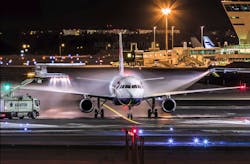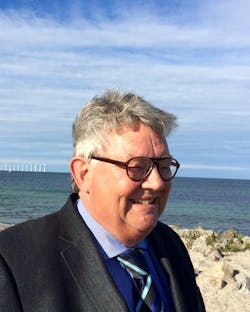How Handlers Navigate Scandinavia’s Winters
Scandinavia is a region of northern Europe consisting of the countries of Denmark, Sweden and Norway. There region is known for its very harsh winters and aircraft ground handling in the region has its own peculiarities due to the often-extreme weather conditions that must be dealt with.
There are approximately 65 airports with regular scheduled traffic in Scandinavia. Not accounting for Longyearbyen in the Svalbard archipelago – which is considered international, the northernmost airport is Hammerfest in Norway and the southernmost is Rønne in the island of Bornholm in Denmark, explains Ivar Busk, owner of Aviation Care Consulting.
“There are about 21 million people living in the three countries and in 2019, before the COVID-19 pandemic, nearly 100 million passengers were air transported,” he says. “The distance between the northernmost Hammerfest and southernmost Rønne is 2,316 km. This makes it necessary to have an effective infrastructure of air transport and therefore the region is a natural breeding ground for ground handling companies.”
Winter Challenges
In Scandinavia, it can be a challenge to operate effectively throughout the year due to the shifting weather. This holds true for both flight and ground operations.
“In the winter, temperatures can go down to -30 degrees C, whereas in some years in the summer they can go up to 35 degrees C. Also, heavy snow, rain and very windy weather demand operational preparedness for both personnel and material,” Busk points out. “Therefore ‘winter’ maintenance of ground support equipment is essential for safe and effective handling. Especially in Norway and Sweden, snow in the winter creates a special situation, whereby normally snow clearance is the airport’s responsibility but the aircraft parking area is often the GSP’s responsibility.”
Indeed, preparedness is the main strategy employed by aircraft ground handlers to manage the challenges associated with ground handling during Scandinavia’s harsh winters, according to Jo Alex Tanem, CEO of Aviator Airport Alliance.
“As opposed to warmer countries, we have harsh winters every winter, and the further up north one goes, the longer the season lasts. All infrastructure is built to deal with heavy snowfall and low temperatures,” he says.
Deicing is also a specialty in Scandinavia in the cold season, which normally lasts from November to April.
“Therefore, effective and efficient procedures have been developed in cooperation with manufacturers of deicing equipment with the most sophisticated technics,” says Busk.
Personnel Retention
The turnover rate for ground handling personnel working in Scandinavia is relatively low, as there often are some extra benefits connected to a ground handling job depending on a GSP’s organization, observes Busk.
“As the aviation industry has changed during the last 30 years, going from airline-controlled ground handling to independent companies, the latter provide different benefits compared to airlines. Today, only two airlines in Scandinavia have their own ground handling services, one is Scandinavian Airlines System (SAS) - but only at their main hubs in Copenhagen, Oslo and Stockholm, and the other is Widerøe, which operates only in Norway,” he says. “During the years, we have seen a number of GSPs trying to open services in Scandinavia, but due to rather high costs it has been difficult to make the ventures profitable and these GSPs have ceased their operation after a short time. Today the largest independent GSPs in Scandinavia are Menzies, Aviator, CFS and Swedavia - which is airport-owned and operates only Sweden. There is also a number of minor companies.”
Normally, the airport type of work is regulated by a high number of organized personnel in different unions, which during the years have been able to improve the working conditions, observes Busk.
“Also, working procedures have changed from nearly manual-only to increasingly more automatic operations. All of this has an influence on the turnover rates as the work does not result so much in physical effort,” he says. “In general, there is a positive atmosphere, which is also in the interest of management, and there are also good chances for promotion within a company.”
Indeed, open and honest communication with staff and unions, as well as empowerment and emphazising a non-hierarchical organization are the best strategies and tactics for the retainment of personnel, according to Tanem.
“This is the Scandinavian way of thinking that everyone is equally important for the success of the company,” he says.
Safety Awareness
Safety is a very important point in all training programs for all GSPs, and aircraft ground handlers in the region are concentrating efforts to raise safety awareness in aircraft ground handling through training.
“We put constant emphasis on safety procedures and processes, just culture and the assessment of the root causes for every discrepancy. Specific to the Nordic region is the emphasis on winter operations,” says Tanem.
Busk observes that today’s training is often conducted as e-learning, but this should never replace on-the-job training.
“In the old days, it was a must that one had to have ‘strong muscles’ to operate in the ramp as the equipment used was very little automatized, but today many parts of the process are computer-controlled and even some of it is robot managed,” he says. “Today, many of those who start as ground handlers have a general transport education directed to aviation and ramp handling. This takes six to nine months and also includes some practical training. Brush up training is also performed in regular schedule and when new aircraft types are handled. IATA’s procedures found in the airport handling manual (AHM) and in the IATA Ground Operations Manual (IGOM) are often the ‘back bone’ of training procedures, and they include a focus on safe operations,” he says.
Impact of COVID-19
It is well known that the aviation industry has suffered in the last year as the COVID-19 pandemic wore on.
“Almost overnight, traffic went from 100 percent to 1 percent, and most of the ground personnel was laid off or made redundant very soon after when it was obvious that there was a global pandemic. Due to this situation, the number of aircraft ground handling incidents was nearly null. But as the industry is now slowly recovering from the pandemic, there is a need for a renewed focus on safety awareness in the perspective of the traffic coming up in gear again,” says Busk. “The reason is that, in many cases, there will be on the ground the same personnel which was dismissed, perhaps as much as 60-70 percent of all personnel, and after a brush-up period there will be a tendency to continue working as before.”
The recovery of the of flight operations in Scandinavia has varied depending on the country.
“In Norway, domestic traffic was not hit as hard as Sweden and, especially, Denmark. International traffic is still reduced in all three countries, but more and more flights are being inserted to accommodate the numbers of passengers, especially the holiday period has given a boost,” says Busk.
The revenue loss in Scandinavia has been in line with the ground handling industry in the rest of Europe, according to Tanem.
“The recovery has begun in June and has continued throughout the summer,” he says. “We have been seeing big differences between the airlines and destinations, but the overall recovery in Scandinavia is in line with the industry in general.”
About the Author

Mario Pierobon
Dr. Mario Pierobon provides solutions in the areas of documentation, training and consulting to organizations operating in safety-sensitive industries. He has conducted a doctoral research project investigating aircraft ground handling safety. He may be reached at [email protected].


